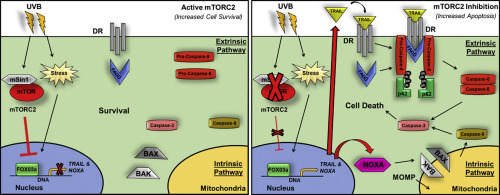Cellular Signalling ( IF 4.4 ) Pub Date : 2018-08-30 , DOI: 10.1016/j.cellsig.2018.08.018 Robert P. Feehan , Amanda M. Nelson , Lisa M. Shantz

|
The primary cause of non-melanoma skin cancer (NMSC) is ultraviolet B (UVB) radiation. We have shown previously that mTORC2 inhibition sensitizes keratinocytes to UVB-induced apoptosis mediated by the transcription factor FOXO3a. FOXO3a is a key regulator of apoptosis and a tumor suppressor in several cancer types. Activation of FOXO3a promotes apoptosis through the coordinated expression of a variety of target genes, including TRAIL and NOXA. We hypothesized that in the setting of mTORC2 inhibition, the UVB-induced expression of these factors would lead to apoptosis in a FOXO3a-dependent manner. Using spontaneously immortalized human keratinocytes (HaCaT cells), we observed that both TRAIL and NOXA expression increased in cells exposed to UVB and the TOR kinase inhibitor Torin 2. Similar to knockdown of FOXO3a, NOXA knockdown reversed the sensitization to UVB-induced apoptosis caused by mTORC2 inhibition. In contrast, loss of TRAIL by either knockdown or knockout actually enhanced expression of nuclear FOXO3a, which maintained apoptosis. These surprising results are not due to faulty death receptor signaling in HaCaT cells, as we found that the cells undergo extrinsic apoptosis in response to treatment with recombinant TRAIL. Even more striking, TRAIL knockout cells were sensitized to recombinant TRAIL-induced apoptosis compared to wild-type HaCaT cells, with the largest increase occurring in the presence of mTORC2 inhibition. Taken together, these studies provide strong evidence that mTORC2 controls UVB-induced apoptosis by regulating NOXA expression downstream of FOXO3a. Moreover, FOXO3a transcriptional activation by mTORC2 inhibitors may be a valuable target for prevention or therapy of NMSC, especially in cases with low endogenous TRAIL.
中文翻译:

抑制mTORC2通过依赖FOXO3a转录靶标NOXA但不依赖TRAIL的机制增强UVB诱导的角质形成细胞凋亡。
非黑色素瘤皮肤癌(NMSC)的主要原因是紫外线B(UVB)辐射。以前我们已经表明,mTORC2抑制作用使角质形成细胞对由转录因子FOXO3a介导的UVB诱导的细胞凋亡敏感。FOXO3a是几种癌症类型中凋亡的关键调节剂和肿瘤抑制因子。FOXO3a的激活通过多种靶基因(包括TRAIL和NOXA)的协同表达促进细胞凋亡。我们假设在mTORC2抑制的情况下,UVB诱导的这些因子的表达将以FOXO3a依赖性方式导致细胞凋亡。使用自发永生的人类角质形成细胞(HaCaT细胞),我们观察到暴露于UVB和TOR激酶抑制剂Torin 2的细胞中TRAIL和NOXA表达均增加,类似于FOXO3a的敲低,NOXA组合式逆转了由mTORC2抑制引起的对UVB诱导的细胞凋亡的敏感性。相反,通过敲除或敲除损失TRAIL实际上增强了核FOXO3a的表达,从而维持了细胞凋亡。这些令人惊讶的结果不是由于HaCaT细胞中死亡受体信号的缺陷,因为我们发现细胞响应重组TRAIL的处理而发生外源性凋亡。甚至更惊人的是,与野生型HaCaT细胞相比,TRAIL敲除细胞对重组TRAIL诱导的凋亡敏感,在存在mTORC2抑制的情况下增加最多。综上所述,这些研究提供了强有力的证据,证明mTORC2通过调节FOXO3a下游的NOXA表达来控制UVB诱导的细胞凋亡。而且,











































 京公网安备 11010802027423号
京公网安备 11010802027423号